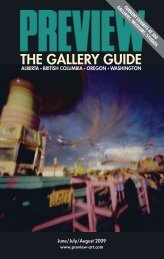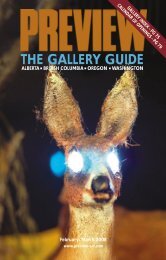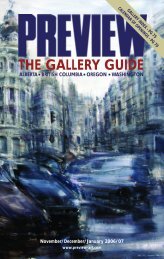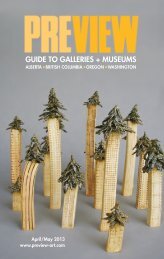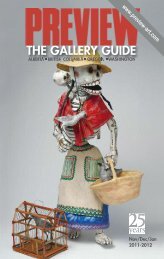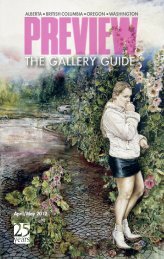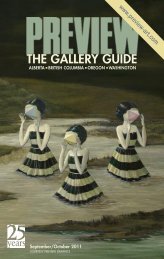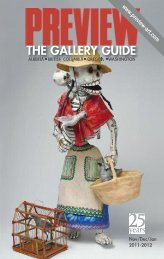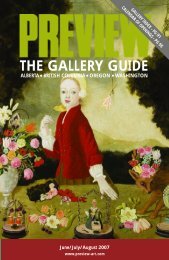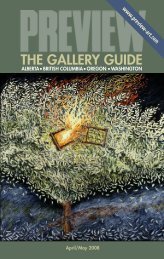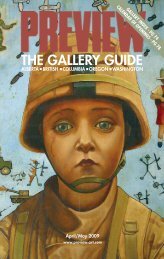Practical Art History orConfessions of a Fine Art AppraiserChapter 11. The Case of Red Fish with Blue Breasts.Several weeks ago I had the pleasure of participating in an Antiques Road-show event tobenefit a local public art gallery. Among the many items I looked at was a coloured silkscreensigned “L. Bellefleur” in the plate .The work was in excellent condition, however, there was no indication of edition number,triage (total number of multiples) or artist’s signature (other than in the plate). This led me tosurmise that the work was probably not artist-made, but rather a commercially producedlimited-edition silkscreen.I recognized the work as a facsimile silkscreen ofCanadian artist Leon Bellefleur’s 1949 oil on canvaspainting entitled Red Fish with Blue Breasts(Poissons rouge aux seins bleus). It was purchased bythe National Gallery of Canada in 1953 from theGalerie Agnes Lefort, Montreal and has been in thenational collection ever since. The work wasexhibited at the Vancouver Art Gallery in the winterLeon Bellefleur, Red Fish with Blue Breasts50 PREVIEWof 1951 as part of a touring show entitledContemporary Painters of Quebec, which includedexamples of younger Quebec artists such as Riopelle, Gauvreau and Dumouchel.Bellefleur was heavily influenced by the work of the contemporary German/Swiss artist, PaulKlee, who was an avid fisherman and juxtaposed scientific and mystic imagery in his worksGolden Fish, Fish Magic and Around the Fish. The similarity of Bellefleur’s titles in thepaintings Red Fish with Blue Breasts and Fish in the City suggest an homage to the master.The imagery in Red Fish with Blue Breasts is suggestive of a collection of strange,otherworldly, and as yet undiscovered sea creatures, each isolated and placed in adjacentholding trays pending further study. The creatures appear to have suggestions of eyes, fins,wings, rudimentary skeletal systems, external bladders, mouths and teeth. The title may refer tohumanities’ need to describe, categorize and understand the unknown.This silkscreen was probably produced circa 1966 by the Markgraf brothers, who hadimmigrated to Canada from Germany in 1957 and set up printing facilities in Quebec. Over thecourse of several years, they were engaged by the National Gallery to reproduce Canadianworks in the national collection. The work was a continuation of a project, initiated some yearsearlier by the gallery’s involvement with the Sampson-Matthews printing company thatincluded silkscreen reproductions of many Group of Seven painters (some of whom hadworked at Sampson-Matthews), and their contemporaries. In 1966 the National Gallery listedthe price of Cat. No. NG41-99, the Poissons rouge aux seins bleus silkscreen, at $14.In a 2004 essay in the Journal of Canadian Art History, Joyce Zemans wrote: “In 1969 AnthonyEmery, Director of the Vancouver Art Gallery, described the Markgraf prints of contemporary art whichhad been created in partnership with the Canada Council. He praised their fidelity and compared their“brilliance” to what he deemed the “porridge and mashed-turnip-coloured [Sampson-Matthews]masterpieces squeegeed desperately through the silk-screens of the National Gallery during World WarII to give the nation’s defenders something to fight for or against.”In December 2004, a Vancouver auction house conducted a sale of silkscreens of the Groupof Seven and their contemporaries produced by Sampson-Matthews, realizing prices upwards of$2,500 each. Perhaps in the not too distant future similar prices for this far superior silkscreenmight also be realized.Next issue: The Case of A.Y. Jackson’s Smart River AlaskaBY JIM FINLAYFINLAY FINE ARTWEALTH MANAGEMENTjim_finlay@telus.net
F i n e A r t S e r v i c e slocal & national transport • packing & crating • worldwide shipping • installation • framing • storage • insuranceDenbigh Design Fine Art Services169 West Seventh AvenueVancouver • BC • Canada • V5Y 1L8Phone • 604 876 3303Email • denbighdesign@telus.netWebsite • www.denbighdesign.comFax • 604 874 0400Hours: Monday - Friday8 am to 4:30 pmtapestries offer an oasis of contemplationand peace, inspired bythoughts of climate change; Oct 4-Nov 11 Anni Hunt, “Fossils and Feathers”,clothing and 3-D pieces withexquisite detail using a variety of surfacedesign techniques.Framagraphic FramingGallery1116 W Broadway ✆604-738-0017www.framagraphic.common-fri 9:30am-6pm sat 10am-5pmSpecializing in contemporary Canadianand international limited editionprints and posters. Works availableby Alvar, Boulanger, Delacroix,Dojer, Harrison, Hessam, Hiscock,Lively, McKnight, Mihanovic, Otsuka,Pradzynski, Sugiura, Tarkay andTickner.Gallery at HycroftUniversity Women’s Clubof Vancouver1489 McRae Ave ✆604-731-4661http:www.uwcvancouver.caOpening receptions: public welcomeGallery viewing: by appt Thru Sep.26Natalia Vetrova, a reflection on whatis important in figurative art, 19 oilpaintings in realistic style with decorativeelements, opening reception:Sep 9 2-3:30pm Sep 28-Oct.30Melanie Cossey, “Light! It has infinitemoods and characteristics!”,through pastel, acrylic and oil Cosseystrives to make the viewer aware thatlight permeates every aspect of ourlives, giving life to everything it touches,opening reception: Sep 30 2-3:30pm.Gallery Gachet88 E Cordova St ✆604-687-2468www.gachet.orgwed-sun 12-6pm Sep 7-30 JennyHam, Farheen Haq, Mona Kamal,Mae Leong and Cindy Mochizuki,“Embodied Terrain”, works in photography,mixed media installation,sound art and textile installation contestthe personal and collective traumasof migration; Oct 5-28 WingDiocson Yap (Montreal), “Maleta(suitcase)”, features a large scale triptychmural addressing the commonexperiences of Filipinos migrating toCanada; Sinag Bayan Cultural Collective,curates a 20-artist group exhibitionof visual art and video installationsby emerging and professionalVancouver artists of Filipino descent;Oct 12-27 Mideo Cruz and RacquelDe Loyola, Philippine-based performanceartists in-residence collaborateKim Dorland, Trampoline (<strong>2007</strong>), oil,acrylic and spraypaint on canvas [SkewGallery, Calgary AB, Sep 6-Oct 6]with the Filipino art community onwork highghlighting migrant workers’realities in Canada.★ Gallery Jones1725 W 3rd Ave ✆604-714-2216www.galleryjones.comtues-fri 11am-6pm sat 12-5pm Sep5-29 Tricia Cline, unique, highlydetailedporcelain sculptures act asvisual fables as they bridge the gapbetween animal and human conditions;Oct 2-30 Peter Aspell, knownfor his evocative and sometimesprovocative portraits painted tirelesslyuntil his death in 2004. This exhibitincludes a selection of paintings fromthe estate that have not previouslybeen shown, as well as some of hismost raw and energetic works.★ Gallery of B.C. Ceramics1359 Cartwright St, Granville Island✆604-669-3606www.bcpotters.comdaily 10am-6pm Thru Sep 3 LynneJohnson, “Illusion of Shadows”,Kohiki inspired functional tableware,garden decor and lanterns; Sep 14-30 Vancouver Collects, inauguralVancouver Collector’s Exhibition featuresselected ceramics from the privatecollection of UBC professor anddirector/curator Scott Watson, consistingof ceramics by BernardLeach, John Reeve, Michael Henryand Wayne Ngan among others; Oct4-29 Sandra Dolph, “ContemporarySculpture”, wall reliefs, vases, shadowboxes and tiles.www.preview-art.com PREVIEW 51
- Page 1 and 2: GALLERY INDEX - PG 82CALENDAR OF OP
- Page 4 and 5: WIM BLOMPAINTINGS2004 - 2007AUGUST
- Page 6 and 7: BRITISHCOLUMBIAFORT ST. JOHNALBERTA
- Page 8: ALBERTABANFFSummit Gallery of Fine
- Page 12: LESLEY FINLAYSONUdell Contemporary7
- Page 16 and 17: previewwww.bellevuearts.orgA Tapest
- Page 18: ELLIOTT LOUIS GALLERY, VANCOUVER BC
- Page 21 and 22: “At the Cove, Hornby Island, BC
- Page 24 and 25: Shannon Belkin: Second NatureSeptem
- Page 26 and 27: GALLERY VIEWSBY ANN ROSENBERGAn Ame
- Page 28 and 29: Peter AspellGALLERY JONES, VANCOUVE
- Page 30 and 31: previewwww.portlandart.orgAili Schm
- Page 32 and 33: Paw Prints Studio & Gallery148 Carr
- Page 34 and 35: CoalHarbourWESTINBAYSHOREDenman StB
- Page 36 and 37: Blazing Bush, oil on canvas, 30 ×
- Page 38 and 39: september 29 to october 20opening s
- Page 40 and 41: La Belle EpoqueVANCOUVER MUSEUM, VA
- Page 42 and 43: Rick Rivet: Paintings 2000-2005KELO
- Page 44 and 45: Lisa Klapstock, Picture 2 - Toronto
- Page 47 and 48: VICTORIA GALLERIESGEORGE LITTLECHIL
- Page 49: Gray's Dock, photogravure etching,
- Page 53 and 54: Inuit Gallery of Vancouver206 Cambi
- Page 55 and 56: long-time collector, Monny, has a p
- Page 57 and 58: Robinson; The gallery is also avail
- Page 59 and 60: Carl Forup, Ole Ring, Janus La Cour
- Page 61 and 62: experienced in Ucluelet and Tofino
- Page 63 and 64: and work from the past several year
- Page 65 and 66: Dales Gallery537 Fisgard St ✆(250
- Page 67 and 68: FIRST ANNUAL FINE ART SALEPresented
- Page 69 and 70: White Rock Gallery1247 Johnston Rd
- Page 71 and 72: nature; Eric Rue, Back Room show;Oc
- Page 73 and 74: pattern in post-WWII art; To Nov 4
- Page 75 and 76: gallery featuring original artwork
- Page 77 and 78: ★ Frye Art Museum704 Terry Ave✆
- Page 79 and 80: THOMASWOODVeneziaSept. 6 - 29, 2007
- Page 81 and 82: Exhibition Catalogues of InterestRE
- Page 83 and 84: Barbara Boldt Original Art Studio 2
- Page 85 and 86: ART SERVICES & MATERIALSBasic Inqui
- Page 87 and 88: GALLERY OPENINGS + EVENTSSeptember




